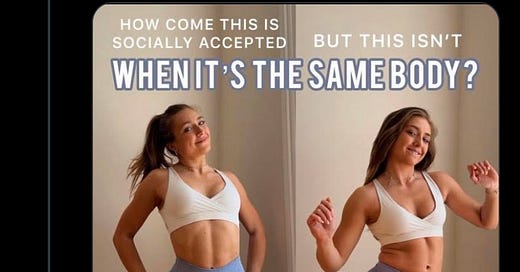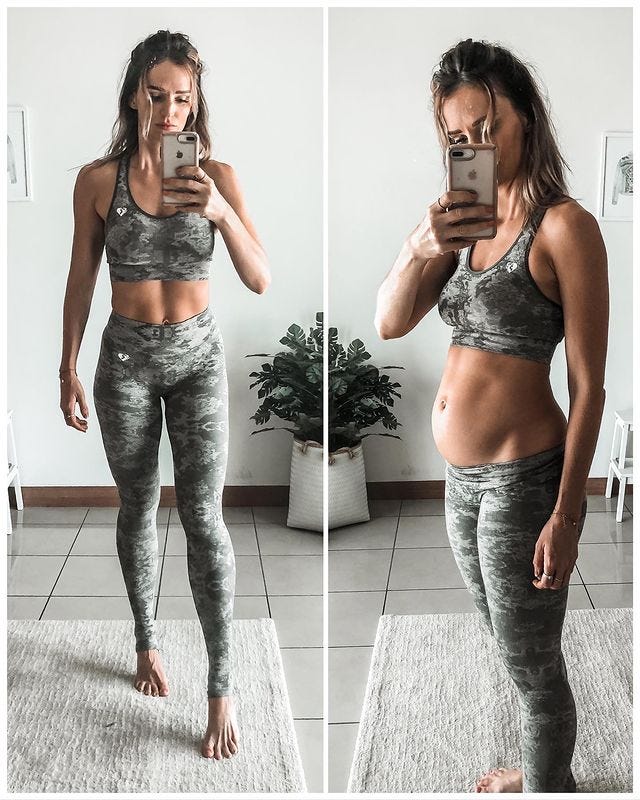On fitfluencers and their tiny fat rolls
These posts aren't brave. But they are representative of a bare minimum principle: Don’t bullshit people.
The tweet above had a viral moment this week (I can’t link it, the account’s now locked). It’s a polarizing topic — tens of thousands of people on Twitter agree that such posts are a scourge, but you also can’t breathe near Fitness Instagram without being flattened by an avalanche of pictures of straight-sized people contorting their torsos or pulling their leggings down to give you a glimpse of their “real” bodies, so clearly there’s market demand:
The issue with the lead image is the phrase “socially accepted.” For that woman to claim that the body on the right is not “socially accepted” — be serious, please. Do we live in a world where some asshole would point out that she’s got body fat on her stomach as a means to insult her? Sure. But what justifiably gets people’s hackles up is when someone with a a body hovering around the top of the hierarchy of social acceptability suggests a legitimately oppressed existence.
However.
I do believe that she and these other posters are attempting to move the needle on what is socially accepted on Instagram. There was a time when it would have been unthinkable to post an image of anything other than what our culture has long considered a “perfect” female body to the platform. Some people’s accounts still operate this way, cough cough:



[As a weight lifter who loves my giant traps: You’re tearing me apart, Kimberly!]
Harboring insecurities or having less than “perfect” bodily features is not as difficult as being shamed, abused, or systematically shut out because you’re fat, disabled, trans, not white, or anything else. I’m straight-sized and muscular but have handfuls of stomach fat and constellations of cellulite on my thighs; I also used to be a plus-sized woman who weighed around 225 pounds in the late aughts. I’ll give you one guess as to which state of being was less socially accepted — and even then, my body was far more accepted than fatter ones. No one who does not live in a marginalized body should insinuate that they do just because their stomach isn’t flat all the time.
But these fitfluencers aren’t paragons of body liberation politics. They’re in the business of sending a message to their target audience, to people they’re actually influencing: Young women who want to be skinny and look “perfect.”
When it’s clear just how harmful Instagram is for young women, I’d argue that fitfluencers actually have a responsibility to make these kind of posts. If their accounts are going to exist, this is a crumb of harm reduction we might reasonably expect from them. These posts shouldn’t be celebrated or confused for a display of bravery. They should be considered representative of a bare minimum principle: Don’t bullshit people at the expense of their mental health.
I understand how limited these posts are in advancing bodily acceptance for all. I also get that they can make someone feel worse about their body. In this post shared by Danielle Catton, she writes: “I can’t pose away the scrutiny and hatred shown toward my body. While the original image I’m sure helps people, they don’t land well with people who aren’t thin for this reason.”
With all due respect: They’re not really meant to land for you at all. They’re not for me, either. I don’t think they’re for most grown women who’ve found a bit more peace with their bodies as they age or who have sought some body image consciousness-raising. The fitfluencer tiny fat rolls posts might make you feel bad about your body, but they’re in response to the fake-perfect images that made her feel bad about her body. Here’s a thought: Instagram is mostly bad for everyone with a body, so ignore the accounts that aren’t psychologically or practically good for you. I believe these fitfluencer posts are good for many of the people who see them.
Young women who want to look like their favorite fitfluencers — typically straight-sized, thin, “toned,” just the “right” degree of curvy, etc. — should see these posts that exemplify how no workout, eating plan, posing, or clothing eliminates your humanness; even your #goals girlies are just souls in skin bags. Thin women have cellulite. Girls with abs get bloated. Boobs sag. That shapely ass looks different when she stands normally. None of these things needs to be “normalized” because none of them is abnormal. Maybe you know this, but they don’t. Let them learn.
Ideally, young women would see all kinds of bodies on their grids. They’re not going to if they only follow thin fitfluencers, and I hate to say it, but if they’re following that kind of girl, that’s probably the main kind of girl they follow. But if these fitfluencers at least lift the veil a little, impressionable people can see more accepted images of the normal body things most of us have — cellulite, fat, stretch marks, hyperpigmentation, body hair — even if some of us have more of it than others. Maybe they’ll come to realize these things are OK sooner than I did at their age.










Very much agree. I think people need to internalize that not every post/reel/meme on Instagram (or the internet at large) is meant for them. When I was a teen in the early aughts (the peak of "thin is in"), I would have found Danae Mercer's content revolutionary for my self-esteem (even in my privileged body). I was starved for images of real, non-perfect, larger-than-a-size-2 women.